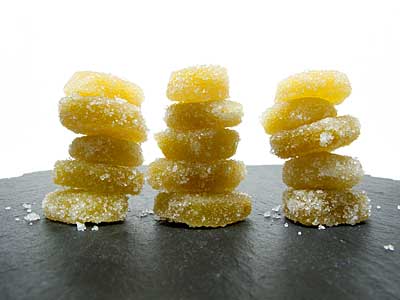September 19, 2011
Mignardise

gingembre confit
(crystallized ginger)
As a young child, my impressions of San Francisco’s Chinatown were garnered from the back seat of a ’55 Chevrolet while my father would drive up Grant Avenue with out-of-town family in tow. There was also one cold winter night where my uncle took me to the annual Chinese New Year’s Parade. Later, after I had my driver’s license, I would drive into the City, park with dates at the Portsmouth Square Garage, and from there, we’d walk up Washington Street to a restaurant I knew. I no longer remember its name, but I still remember walking down the stairs from the street. The restaurant was located in a basement. It still had private, curtained-off booths along the walls and a few tables in the center of the room. The bathroom was located underneath the sidewalk. I don’t think dinner ever cost more than five dollars for the two of us. Some dates found it adventuresome, others thought the place was scary and dirty.
On the corner of Grant and Washington, on the same side of the street as the restaurant and a half a block before it, was sort of an open-air newspaper stand built into the wall. Besides the local Chinese-language papers, they sold various, cheap, made-in-Japan, touristy trinkets and a couple of snack-food items in cellophane bags. Those snacks included candied coconut and crystallized ginger. Sometimes, I would drive into the City just to stop at this stand and buy coconut and ginger. I thought the stuff was really yummy. My friends thought it was disgusting.
After I finished high school and left home for a few years, I stopped longing for candied coconut and crystallized ginger. Now, 40 years later, when visiting my mother-in-law in Maui, there’ll occasionally be crystallized ginger in the pantry and I sneak a piece or two. It’s something I always thought about making, but never got around to it. Recently, I decided to give the process a whirl.
I tried a couple of recipes from the Internet without much success. They all seemed to have too many steps and too many imprecise, awkward instructions. Then I found one at a blog called Brooklyn Farmhouse that gave me an idea, and success soon followed.
I start off with good-quality ginger that I peel and cut into 3 mm (1⁄8-in) thick rounds. If the ginger thumbs are too skinny, you can cut them on a bias, but rounds are easier to make consistent. The ginger pieces are weighed and placed in a saucepan along with an equal weight each of granulated sugar and filtered water. The saucepan is placed over high heat and when the sugar is all dissolved and the liquid bubbling nicely, the heat is reduced to maintain a few bubbles. The ginger should be fully submerged in the liquid. This can be pretty much left alone for an hour while the ginger slowly cooks away. Keep an eye on the pot, and make sure it doesn’t dry out. Stir it occasionally, if you have a mind to.
When the ginger is about finished, toss a scoop of sugar onto a rimmed baking sheet. I use cane sugar that I get at a Mexican market because it cheaper than the American brands. The crystal size is slightly larger, but not as large as sanding sugar. Drain the ginger, reserving the syrup for other uses. Toss the cooked ginger pieces in the sugar until no more sugar will stick to them. Arrange the ginger pieces on a parchment-covered baking sheet until cool. Finally, store the crystallized ginger in a sealed jar. It should have a shelf life of many years, but it won’t stay around that long unless you hide from yourself.
© 2011 Peter Hertzmann. All rights reserved.
